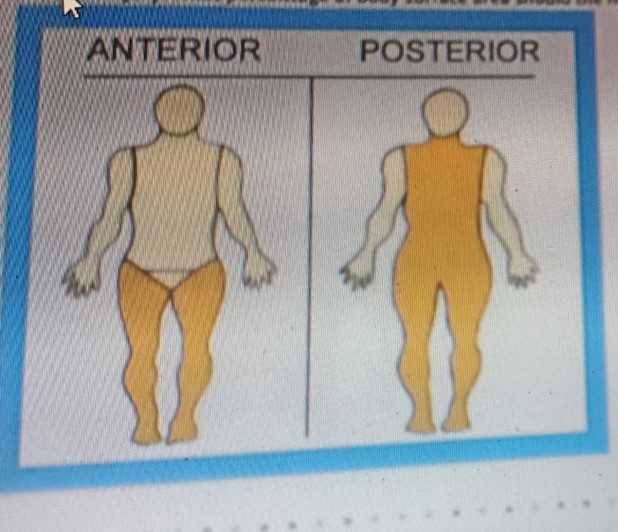A nurse is admitting a client who sustained severe burn injuries. The nurse refers to the rule of nines to determine the total body surface area of Your injury What percentage of body surface area should the nurse estimate the client has burned?

The Correct Answer is ["54"]
Rationale: This is because according to the rule of nines, the lower limbs anteriorly and posteriorly will account for 18% each, and the back accounting for 18%
So, the TBSA will be, (18+18+18) =54%
Nursing Test Bank
Naxlex Comprehensive Predictor Exams
Related Questions
Correct Answer is A
Explanation
Choice A rationale: the epidermis becomes thinner and more fragile with age hence making the skin of elderly individuals more prone to injury, bruising, and infections.
Choice B rationale: this is incorrect because the skin in old age loses its elasticity and becomes more wrinkled due to the loss of collagen and elastin fibers responsible for maintaining the elasticity of the skin.
Choice C rationale: subcutaneous tissue comprising mainly of fat and connective tissue increases with age especially in regions such as the abdomen.
Choice D rationale: blood vessels within the skin become narrower and less efficient with increasing age thus resulting in decreased blood flow and oxygen delivery to the skin.
Choice E rationale: sebum production which is responsible for skin lubrication increases with age thus making this statement incorrect.
Correct Answer is C
Explanation
Choice A rationale: Herpes zoster itself is not easily spread, but the varicella-zoster virus can be transmitted to individuals who have not had chickenpox or the varicella vaccine.
Choice B rationale: While the virus can be spread through contact with the fluid from shingles blisters, it can also be spread by respiratory droplets from the infected person.
Choice C rationale: Postherpetic neuralgia is a common complication of herpes zoster (shingles), and it involves persistent pain in the affected area even after the lesions have healed.
Choice D rationale: This statement is accurate, but it does not address the persistent pain (postherpetic neuralgia) that can occur after the lesions resolve.
Whether you are a student looking to ace your exams or a practicing nurse seeking to enhance your expertise , our nursing education contents will empower you with the confidence and competence to make a difference in the lives of patients and become a respected leader in the healthcare field.
Visit Naxlex, invest in your future and unlock endless possibilities with our unparalleled nursing education contents today
Report Wrong Answer on the Current Question
Do you disagree with the answer? If yes, what is your expected answer? Explain.
Kindly be descriptive with the issue you are facing.
